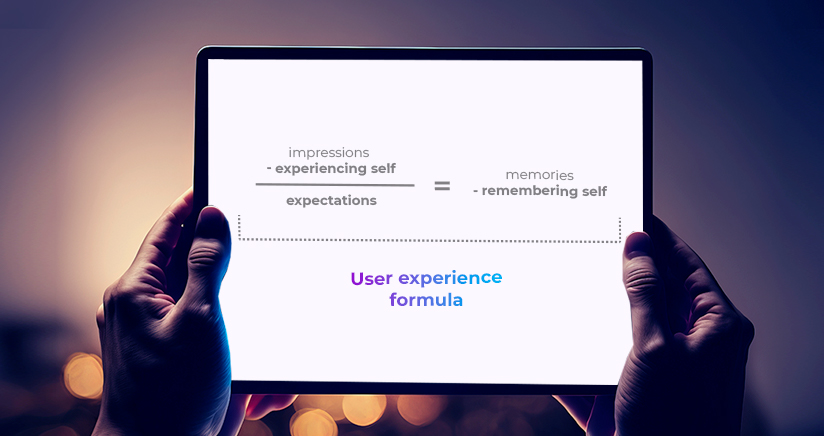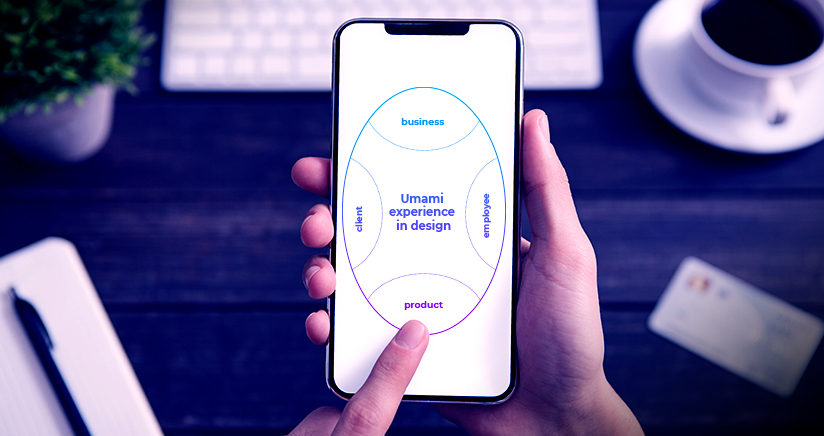Customer Experience and that “something” that will drive your sales.
Designing a business experience is like the UMAMI taste. You need solid knowledge about combining certain ingredients and leveraging your team’s passions to get that special something. “Something” that will make your services or products memorable and stories about them sharable. In this article, you will learn what inspires us in the financial industry, where the most innovative and competitive solutions are created.
User/Customer experience is a term used currently by everyone, everywhere and in every variety. So used, but is it understood? Most people understand it intuitively, but meanwhile, specific business knowledge and strategies are behind it, such as the umami strategy. Inspired by Aga Szóstek’s book “The Umami Strategy”, we invite you to discover together the competitive advantage and prepare a business proposal composed from the “Remembering Self”.
“The Remembering Self” (i.e., our memories) reflects how your customers will remember your service or solution, not just what specific actions accompany their “experience.” So complicated? Aga Szóstek created a simple recipe for it (attached below)¹, from which our UX Lab creates more and more umami solutions with its experience and mastery.

Rational choices – hot or not?
Where do we start with our design and any creative process? First, we must gather invaluable knowledge about the service or solutions users. We do this while mapping their experience (impressions) at each stage of the customer journey map (read more about it here). The more insightful and efficient we make this process, the more data we collect for the next stage. The second stage is understanding and verifying your customer’s expectations with your business and operational capabilities. All this effort is made to create a remarkable memory that will sell. It will sell another product to a current customer or bring in new customers, those “enchanted” by your ideal composition.
Enchanted customers? After all, in finance, there is no space for such understatement, and our partners’ choices are rational. There are supported by tables, statements and numbers. Indeed, there’s much truth in that. But B2B relationships are increasingly seasoned with a pinch of emotion, as confirmed by study after study and business reports. And it is the financial industry, full of similar solutions and products with heightened standards, that is a perfect example of how competitive advantage comes from that umami “something”. Something at the inspiring junction of memories and building long-term relationships.
Unforgettable and lasting memories are invented patiently. Our experiences begin with the first impression. However, numerous studies in behavioral economics show that first impressions do not significantly impact how we remember an interaction with a brand. Instead, our memories are most influenced by 2 factors: what kind of experience it was at the moment of strongest emotion and what we felt at the end of our experience.² At the same time, our brain is a powerful statistical machine that constantly categorizes and remembers all the events around us. After all, we define and experience different things daily and form hypotheses (expectations).
This creates the “image” of the brand, strengthened based on more or less rational choices. But what wins at the moment of decision? Why is it easier to give a list of brands we strongly dislike but difficult for us to name those with which we have an emotional bond? Havas, one of the largest global marketing communications agencies, in 2019 released a study showing that 77% of brands worldwide are indifferent to customers. In other words, these brands might not exist… There may be a transactional nature to the relationship with these brands, explaining their neutrality. At some stage, we choose a product or solution based on utility, reliability and functionality. However, research proves that there is still that winning “something”.
In 2000, Noam Tractinsky, Adi Katz, and Dror Ikar of Ben-Guorion University in Israel searched for an answer to what is more important: the usability of a solution or its aesthetic features, which are undeniably linked to emotions. They designed four different ATM interfaces and surveyed their users to find that the better-looking interface was considered more valuable, even if, objectively and functionally, it was not. Therefore, our perception is not solely based on what we see, hear, or read. We also perceive the companies and brands around us through the prism of what feelings they evoke in us, just like the world and people around us. In addition, our brains very often create simplifying mechanisms, especially for the most complex decisions.³ Trying to guess which decision to make based on our remarkable memories and emotions.

Rational choices or emotions? These two opposite worlds operate in a very close relationship. We can describe their relationship with the statute as “it’s complicated” 😉 However, proven business practices and strategies, in the hands of an experienced chef, will handle these relationships very well.
UX edge – basics and motivating factors toward remarkable experiences
When interactions with the world around us are successful, and the tools or products we use in our work meet or exceed our expectations, we feel satisfied with ourselves. If we attribute some of this satisfaction to a service or solution, we will value the associated brand and build a lasting business relationship.
A product or solution, created per all good UX practices, starts any positive relationship and any memory that stays with us for a long time. Each service and solution must meet basic pragmatic requirements for a customer or business partner to begin considering or comparing your offerings. Their absence means negative selection. Without these requirements, customers will be discouraged by your product or brand before you start building any relationship. These basic requirements are:
- functionality and the associated Minimum Viable Product (MVP);
- reliability tied to each brand’s individual tolerance zone;
- usability sticking to the following principles: usefulness, consistency, simplicity, communication, efficiency and error prevention.
We still have to include aesthetics among the basics. After the success of the Apple brand and the 2000 Israeli study cited above, we assumed that no additional arguments are needed to support this hypothesis.;) The visual appeal of a bank platform or app is an excellent introduction to building a lasting relationship with your customer. Like a tasty appetizer that stimulates our taste buds and is a great promise of quality with the main course.
Once we have the basics, what’s next? We need help to keep the customer with us for as long as possible. Customer loyalty to a brand is determined by motivating factors such as empathy, pleasure, commitment and a sense of meaning. A brand that wants to be “chosen” and build special relationships with its customers or partners appeals to one of the 4 motivators identified above in its strategy (like in the picture below inspired by Aga Szóstek)⁴.

Empathy in the financial industry can take many shapes. From personalized, caring, and attentive customer service; by creating a personal emotional relationship with the customer; to transparency when something goes wrong. On the other hand, pleasure is based on the element of surprise and joy, which, in a world so connected to our finances, is becoming increasingly visible in banking applications or innovative financial wellness services. As we advance, we will get engagement for our brand by meeting needs such as the need to learn, grow and belong, gaining engaged banking customers who generate 37% more annual revenue than other customers.⁵ We can also support the local community, like Umpqua Bank, which calls its branches “stores” and provides them as spaces for cultural events.
Finally, there’s the sense of meaning. People are more willing to make choices that make them feel competent, self-reliant and socially responsible. Meaning is the ultimate goal, aligning with our values and connecting our emotional and rational sides.
It sounds beautiful, only how to design it? It would help if you had solid tools and the right know-how. Our UX Lab will help you build the foundation and choose your motivating factor to create the best solution ahead of your customers and competitors’ expectations. We’ll discover your business umami factor together and have fun doing it.
Umami in business – traditionalism versus risk
Building a strategy around a motivating factor is a complicated process. With the right partner or know-how, it doesn’t have to be a long-term process, but it requires a lot of commitment and experience (you can read about the smooth execution of DesignSprint here). It also involves risk if you want to stand out. Of course, the word “risk” is not the most desirable in the financial industry 😉 but when it comes to strategy and building a competitive advantage, keeping the old solutions can be the biggest risk.
At the same time, all business decisions, even the risky ones, must be well balanced. Creating a diverse experience means seeking a balance between fundamentals and motivating factors. If the focus is only on fundamentals, customers’ relationship with the brand will stop at the transactional level and may end when better offerings from competitors come. On the other hand, if one appeals only to motivating factors, the offer will be unique and memorable but may be lower in quality. Therefore, creating a solid foundation and then appealing to emotions will make your solution competitive and build lasting relationships with your customers.
An adequately outlined vision for your company is crucial at this stage. The more unique and specific, the better. It’s not about being the fastest or cheapest; it’s about inspiring your customers and partners. It can be a “founding myth” or an attempt to define the ideal customer of the future for whom you are developing your solutions. So the most important thing is creating a story they will remember and want to identify with.
That taste…of victory 🙂
In order to bring your unique vision to life, it’s essential to understand the changes you need to implement. And here, economic indicators showing your customers and partners that you are moving in the right direction are crucial. It’s also important to identify what sets you apart and use that as your foundation for success. Finally, by passionately describing the strengths of your service or solution, you can invite your customers on an exciting journey. You can take bold risks with the right business partner while maintaining control. Additionally, it’s vital to design experiences that can be scaled across your organization and align with your business priorities.
At UX Lab, we have experience guiding organizations through this process. We understand that innovation isn’t just about cutting-edge technology and algorithms but also about the people behind it – such as our team of #AilleronExperts. Check our remarkable team here.
Footnotes:
- Aga Szóstek, BIS Publishers 2021, “Strategia Umami. Jak połączyć biznes z projektowaniem doświadczeń i wyróżnić się na rynku”, p. 38
- Haque, U., 2011, The New Capitalist Manifesto: Building a Disruptively Better Business, Harward Business Press
- Marzano R.J., Pickering D, Pollock J.E.,2002, Classroom Instruction That Works: Research-based Strategies for Increasing Student Achievement
- Aga Szóstek, BIS Publishers 2021, “Strategia Umami. Jak połączyć biznes z projektowaniem doświadczeń i wyróżnić się na rynku”, p. 69
- Gaver W., Boucher A., Law A., Pennington S., Bowers S., Beaver J., Humble J., Kerridge T., Villar N., Wilkie A., 2008, Treshold devices: looking out from the home,”Proceedings of the SIGGHI Conference on Human Factors in Computing Systems”, p. 1429-1438
Author’s note: This article was created thanks to the cooperation with #AilleronExperts from UXLab and based on Aga Szóstek’s book “The Umami Strategy”.

 Polski
Polski
 Deutsch
Deutsch






